Receiving your first hearing aids is such a transformative moment that will significantly change your way of living. Whether you are rediscovering the gentle chirp of birds outside your window or seeking clearer conversation with loved ones, this small device opens doors to the world of sound. However, new users often feel overwhelmed or unsure of what to do next.
From day one to six months, this guide offers a comprehensive road map to help you comfortably acclimatise and adjust to your hearing aids. You will have a better understanding of typical problems, useful solutions, and when to get more help at the conclusion of this post. Let’s go off on the path to pleasant, clear hearing.
Getting Started: Before You Wear Your Hearing Aids
1. Understanding Your Hearing Loss Profile
Each hearing loss is unique. Your audiologist at SFL Hearing Solutions will review your audiogram, a chart showing the softest sounds you can hear at different frequencies. This personalized map informs how your devices are programmed.
High-frequency loss: Difficulty hearing consonants like “s,” “f,” or “th.”
Low-frequency loss: There may be a little background rumbling and soft vowel sounds.
Sensorineural vs. conductive: Sensorineural loss involves inner ear or nerve damage; conductive relates to ear canal or middle ear issues.
Setting reasonable expectations for the adapting process is aided by being aware of your particular loss.
2. Choosing the Right Style
There are several different styles of modern hearing aids. Your decision has an impact on personal taste, comfort, and usefulness.
Behind-the-Ear (BTE)
It has a tiny tube that connects to an earpiece and sits behind your ear. This design is great for those with mild to severe hearing loss. It is a dependable option for daily usage because it also provides more power and durability.
Receiver-in-Canal (RIC)
Similar to BTE but with a small receiver inside the ear canal.
More natural sound quality.
Less visible than BTE.
In-the-Ear (ITE)
This design is custom-made to fit the shape of your ears and it sits comfortably inside the outer ear. This is created particularly for those who struggle with small buttons or controls to make it easier to use.
In-the-Canal (ITC) & Completely-in-Canal (CIC)
Due to its tiny size, it is less noticeable. It could, however, have fewer features because of its smaller size. It suits best for those who are struggling with mild to moderate hearing loss.
Invisible-in-Canal (IIC)
Deep inside the ear canal, making it nearly invisible.
Suitable for mild to moderate hearing loss.
Requires professional fitting and regular cleaning.
We at SFL Hearing Solutions help you choose a style based on your degree of hearing loss, lifestyle, and usability.
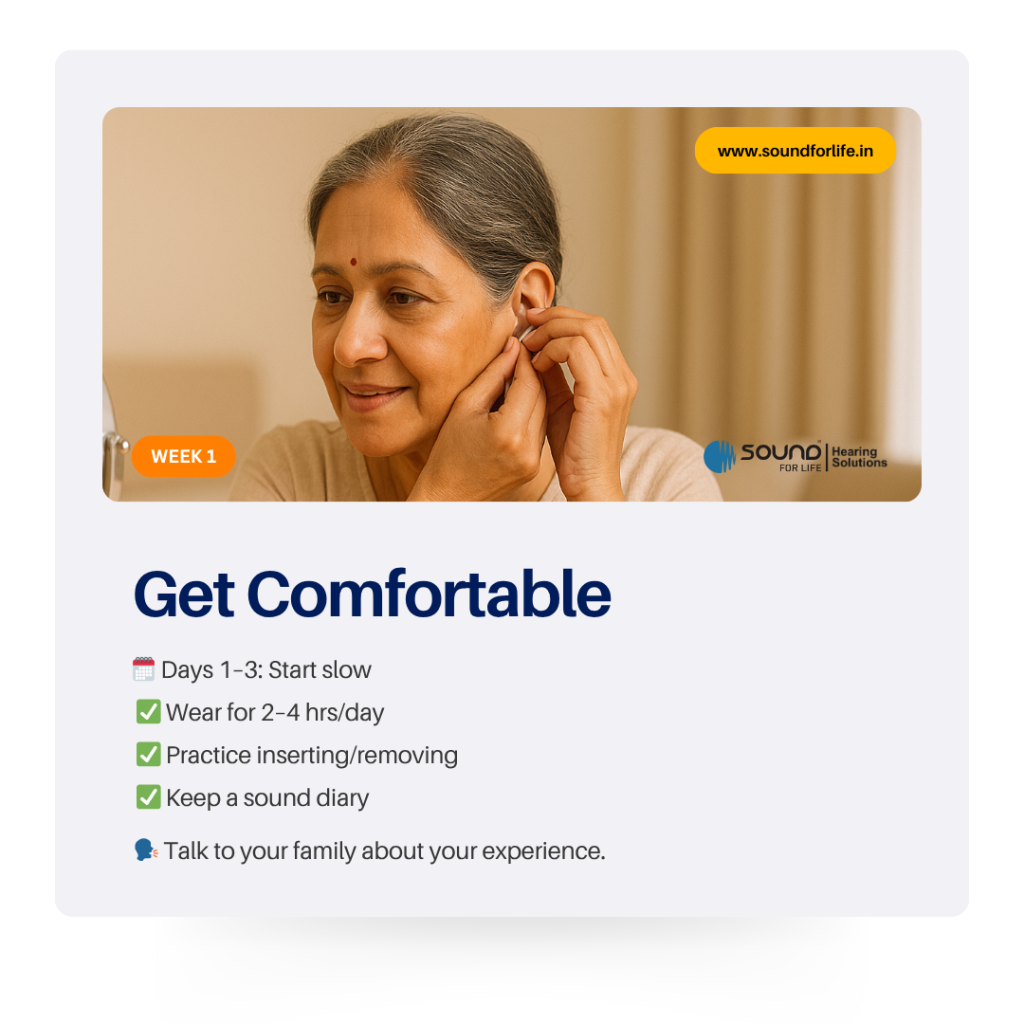
The First Week: Building the Foundation
1. Day 1–3: Introduction Phase
Wear schedule: Begin with spending two to four hours each day in peaceful settings. This avoids ear strain and sensory overload.
You’ll notice that:
- Soft noises are amplified: Your own breathing, rustling leaves, and a ticking clock. It may feel strange to have this sudden riches.
- Occlusion effect: When speaking, the occlusion effect causes a feeling of fullness or echo. It occurs because bone conduction carries the vibrations of your own voice.
- Physical awareness: Contact spots that hurt or feel slightly compressed.
Steps to take:
- Insert and remove your devices in front of a mirror to master technique.
- Listening diary: Take a note of which sounds are too loud, too harsh, or yet weak in your listening journal.
- Talk to your family: Explain what you experience so they can support you.
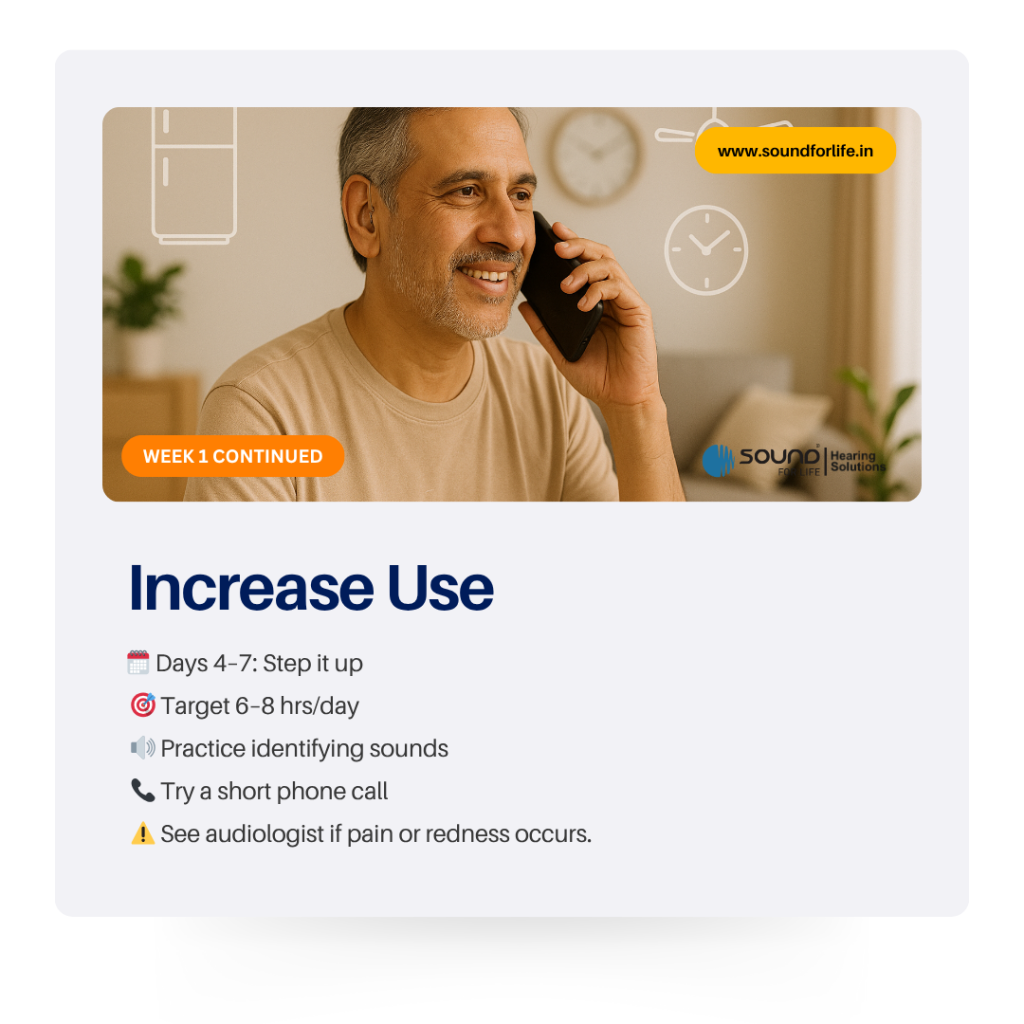
2. Day 4–7: Steady Increase
Wear schedule: Increase the number of hours you wear each day to 6–8. Start with simple, disciplined listening activities.
Listening exercises:
- Sessions of reading aloud: Have a family member or acquaintance read quietly in a room.
- Identification of Sounds: Close your eyes and identify at least five distinct sounds (e.g., clock, hum of refrigerator, distant conversation).
- Phone calls: You can practice one on one calls sound clarity by using your hearing aid’s phone program
- Handling discomfort: While mild irritation is normal, you should see your audiologist if you experience persistent pain or redness. Ear tips can be adjusted for a softer seal.
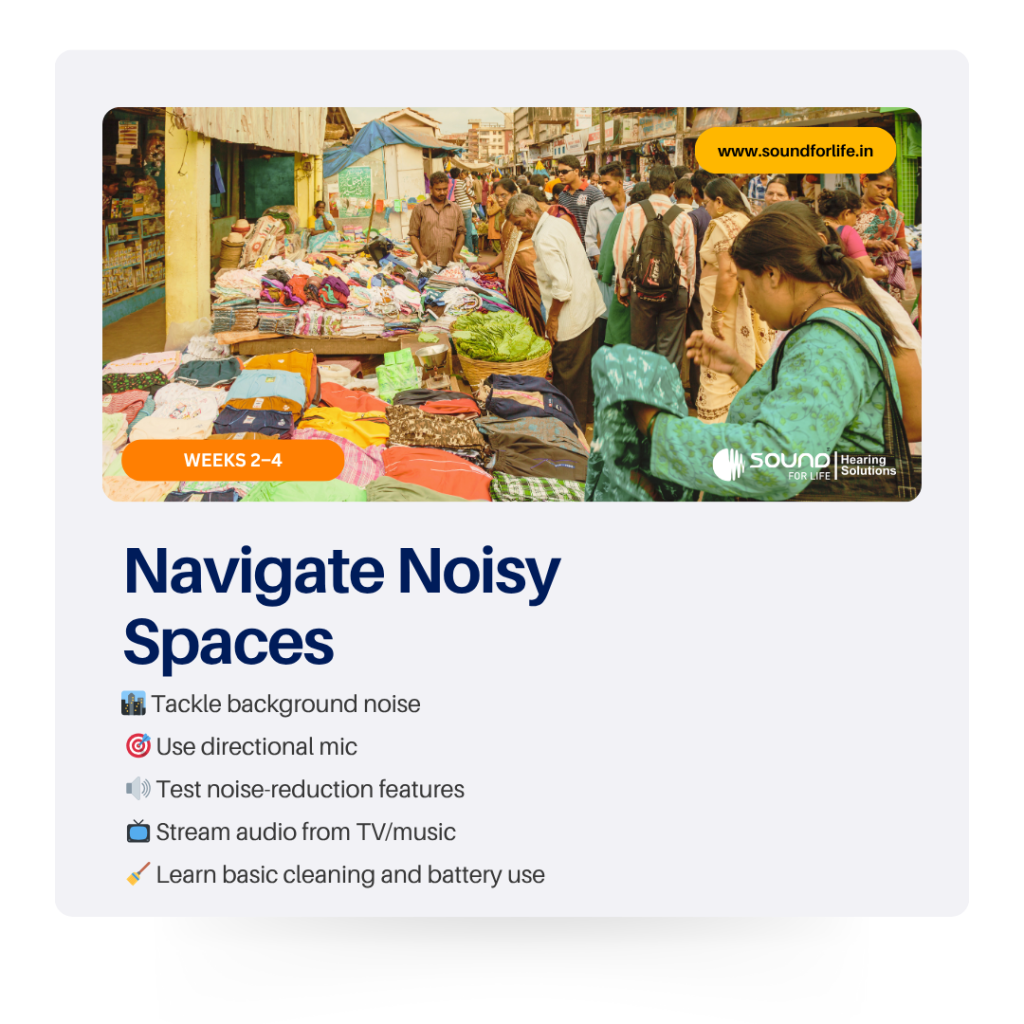
3. Weeks 2–4: Expanding Your Listening World
3.1 Lengthening the Wear Time
Try to wear your hearing aids for 8–10 hours per day. By week four, full-day wear, including daily tasks like walking or cooking is ideal.
3.2 Handling the Problem of Background Noise:
Challenge: Markets and other noisy places might seem chaotic.
Techniques:
- Training with a directional microphone: Many devices focus on sounds in front. Practice turning your head toward speakers rather than amplifying all directions equally.
- Controlled noise exposure: Start with mild background noise (radio at low volume), then gradually progress to busier rooms.
- Use of noise reduction features: Learn how to use any automated noise reduction settings that may be included in your model.
3.3 Battery and Maintenance Routines
- Battery maintenance: For the rechargeable batteries, develop a daily charging schedule and for the disposable batteries learn to change them quickly.
- Cleaning procedure: Use the included tools to remove wax and debris. Use a delicate brush to carefully clean the microphone ports.
- Storage: To extend the life of the gadget, store it overnight in a dry box or dehumidifier.
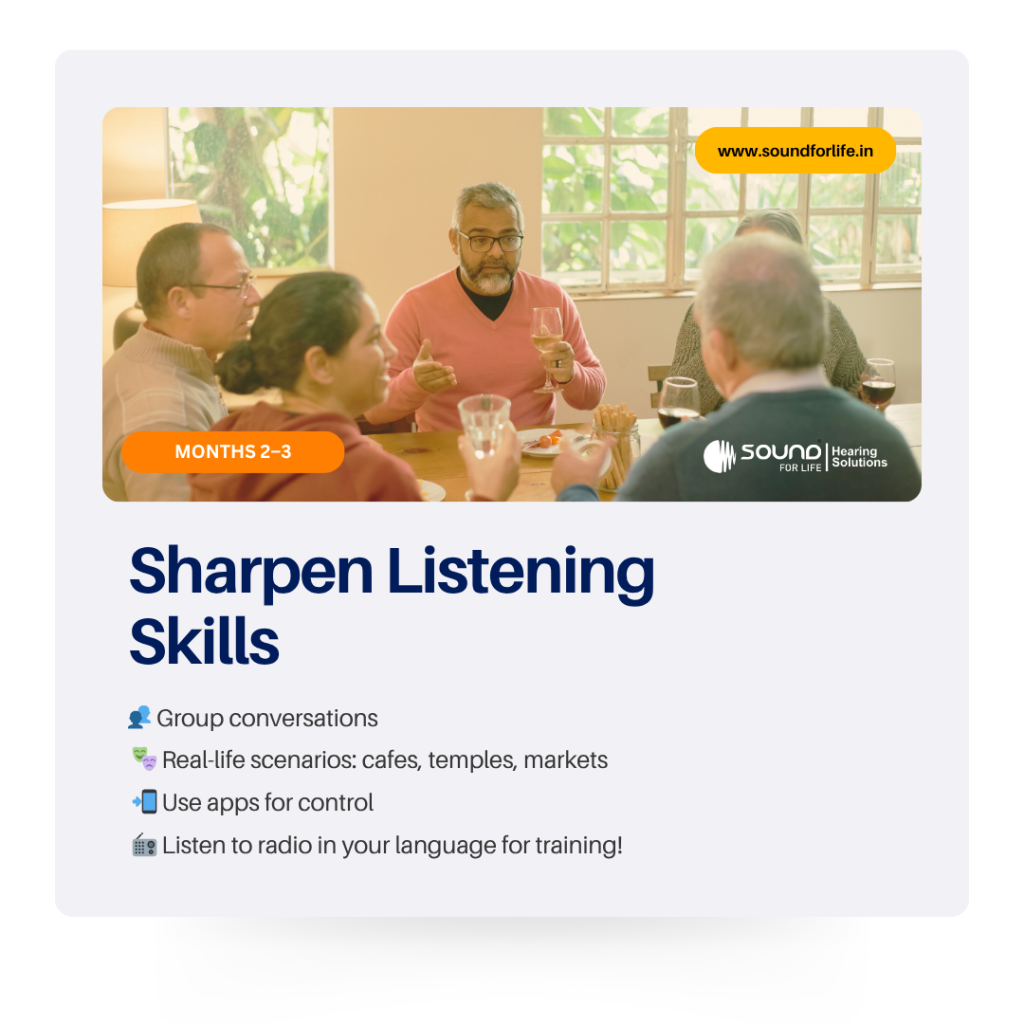
4. Months 2–3: Cultivating Listening Skills
4.1 Conversation in groups:
- Small group practice: Invite two or three people to have a natural conversation, to allow you to focus on lip-reading and asking clarifying questions. Ask them to speak to you in turns.
- Large group dynamics: Move gradually to larger gatherings, like family dinners. Position yourself at a table with fewer overlapping conversations.
4.2 Challenging Situations:
- Restaurants or outside eateries: Use restaurant programs or mute background noise manually. Request seating away from the kitchen or speakers.
- Outdoor events: At temples, fairs, or concerts, practice identifying distinct sounds like temple bells while balancing ambient noise.
4.3 Incorporating Technology
- Smartphone apps: Many modern aids offer apps for volume control, program switching, and sound mapping visualizations.
- Audio streaming: To improve sound quality without environmental interference connect your devices to TVs or music players.
Pro Tip for India: Try listening to familiar radio programs in regional languages. The predictability of voices and content helps your brain acclimatize more quickly.
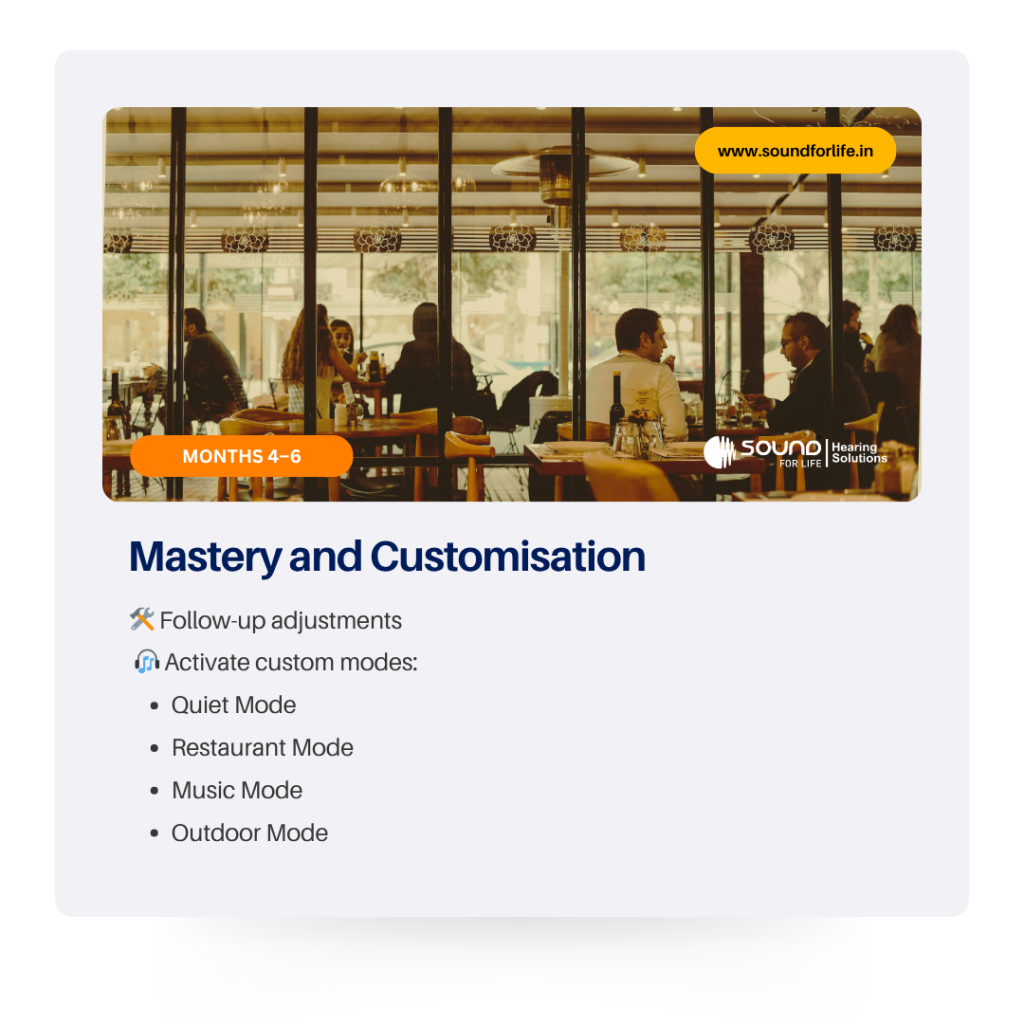
5. Months 4–6: Fine-Tuning and Mastery
5.1 Follow-up Appointments
Visit schedule: Book follow-ups at 6–8 weeks and 3 months post-fitting.
What to discuss:
- Any persistent issues (feedback, unclear frequencies).
- Comfort and fit adjustments.
- Program customisation based on your lifestyle (e.g., office, temple visits, outdoor walks).
5.2 Advanced Listening Programs
Program Name | Best Used For | Benefits |
| Quiet Mode | One-on-one conversations | Reduces ambient noise |
| Restaurant Mode | Busy cafes and family gatherings | Focuses on frontal speech signals |
| Music Mode | Listening to movies, music, prayers | Enhanced sound quality and richness |
| Outdoor Mode | Markets, streets, temple grounds | Balances environmental sounds |
Work with your audiologist to adjust program parameters like gain and compression slope.
6. Tips and Strategies for Faster Adaptation
- Daily Listening Goals: Set a goal to identify and journal five new sounds each day.
- Active Engagement: Listen to audiobooks in your favourite languages—pause, rewind, and reflect on unclear words.
- Visual Cues: Continue lip-reading and observe facial expressions to supplement auditory input.
- Mindful Breaks: Give your ears periodic rests; remove devices if you feel overwhelmed, then resume.
Social Support: Join local hearing loss support groups or SFL-hosted workshops to share tips and success stories.
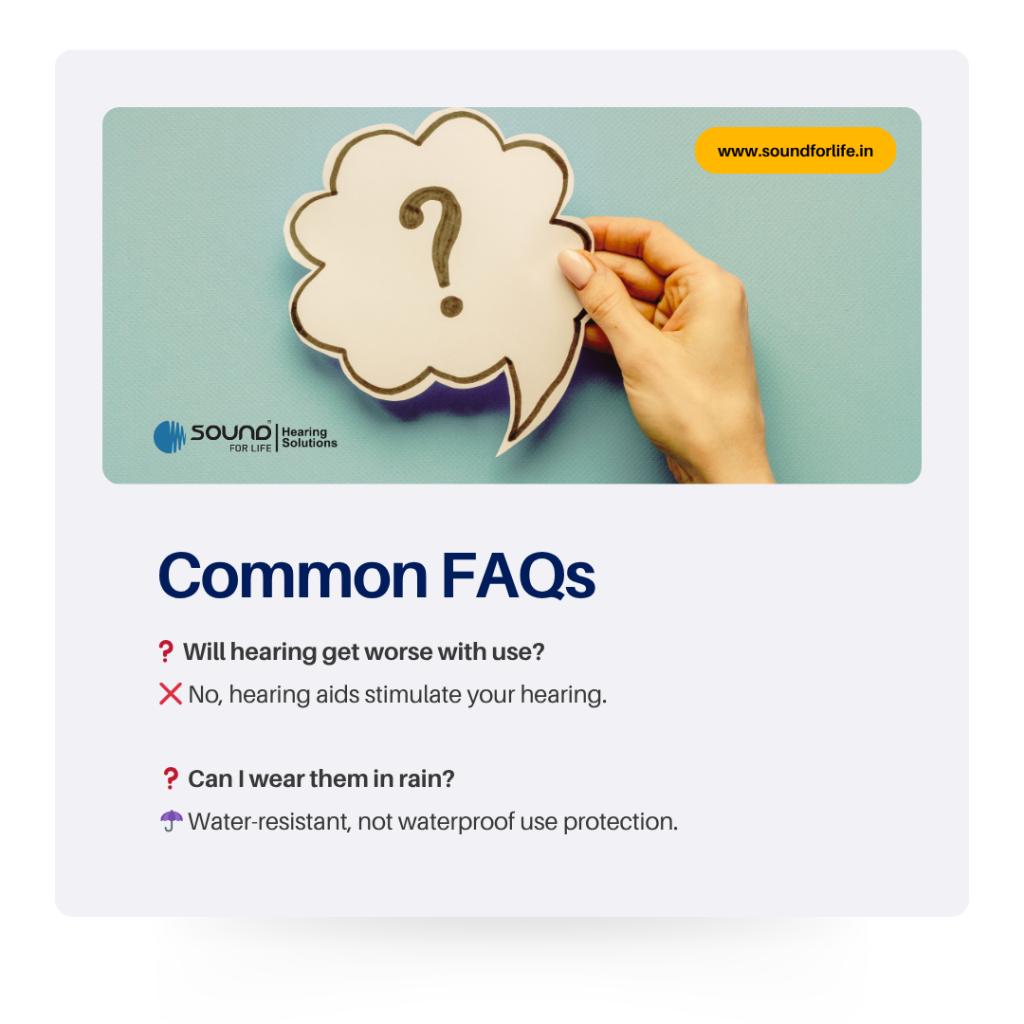
7. Frequently Asked Questions (FAQ)
Q1: How long would it take for me to feel “normal” wearing my hearing aids?
A: By three months, most users see a noticeable improvement, and by six months, they have fully acclimated. The degree of hearing loss and use consistency affect individual outcomes.
Q2: Can I wear hearing aids in the rain?
A: Most devices are water-resistant but not waterproof. Use a protective accessory or umbrella; dry aids thoroughly if they get wet.
Q3: Will my hearing deteriorate faster with constant aid use?
A: No. While they enhance sounds, hearing aids do not result in further hearing loss. In fact, they help by stimulating your auditory circuits.
Q4: Are there government subsidies or insurance options?
A: In India, schemes like the ADIP (Assistance to Disabled Persons) program provide financial aid. Some private insurers offer partial coverage; check your policy terms.
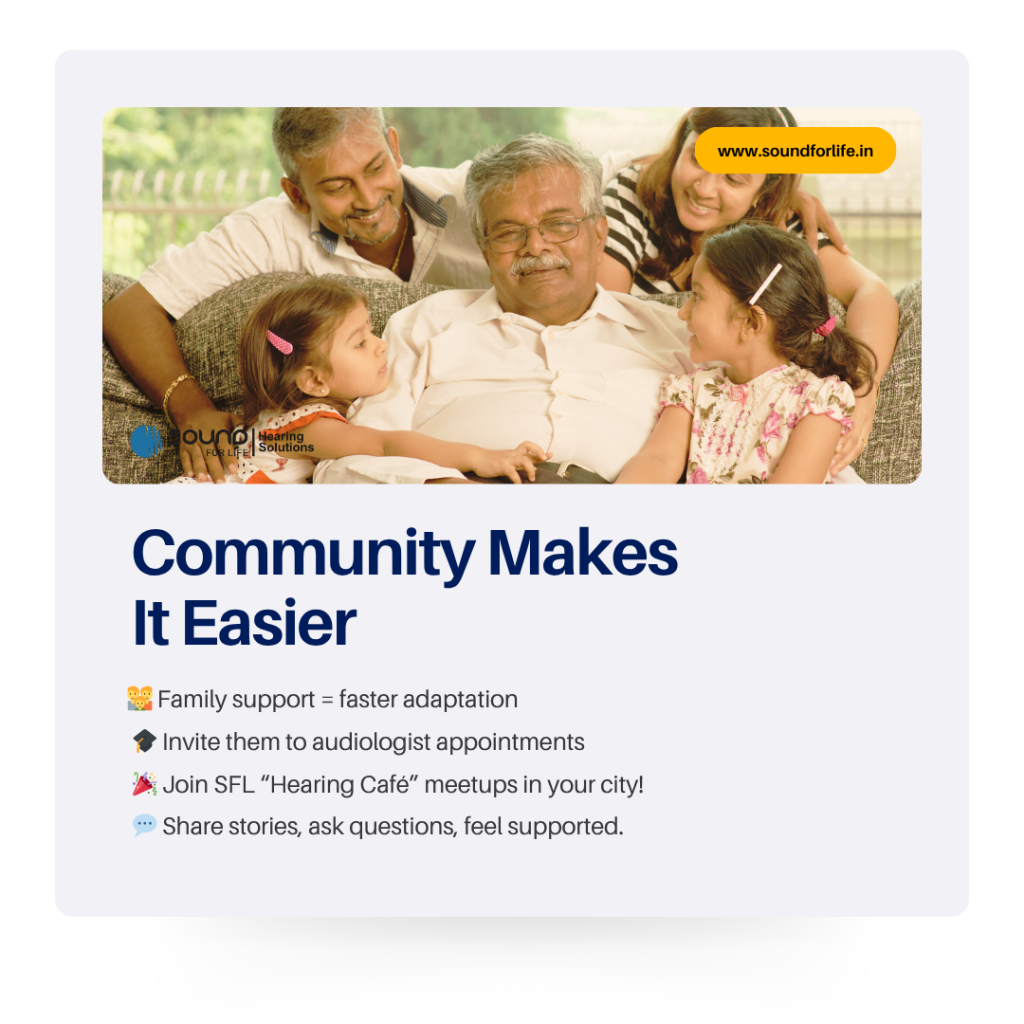
8. Community and Family Involvement
Hearing aid success thrives on teamwork.
Encouragements:
- Family training sessions: During your visit to audiologists, bring your relatives to understand the best communication practices.
- Patience and clarity: Ask speakers to face you while speaking, talk clearly, and avoid covering their mouths.
- Positive reinforcement: Celebrate each accomplishment such as your first group conversation, first movie without captions, etc.
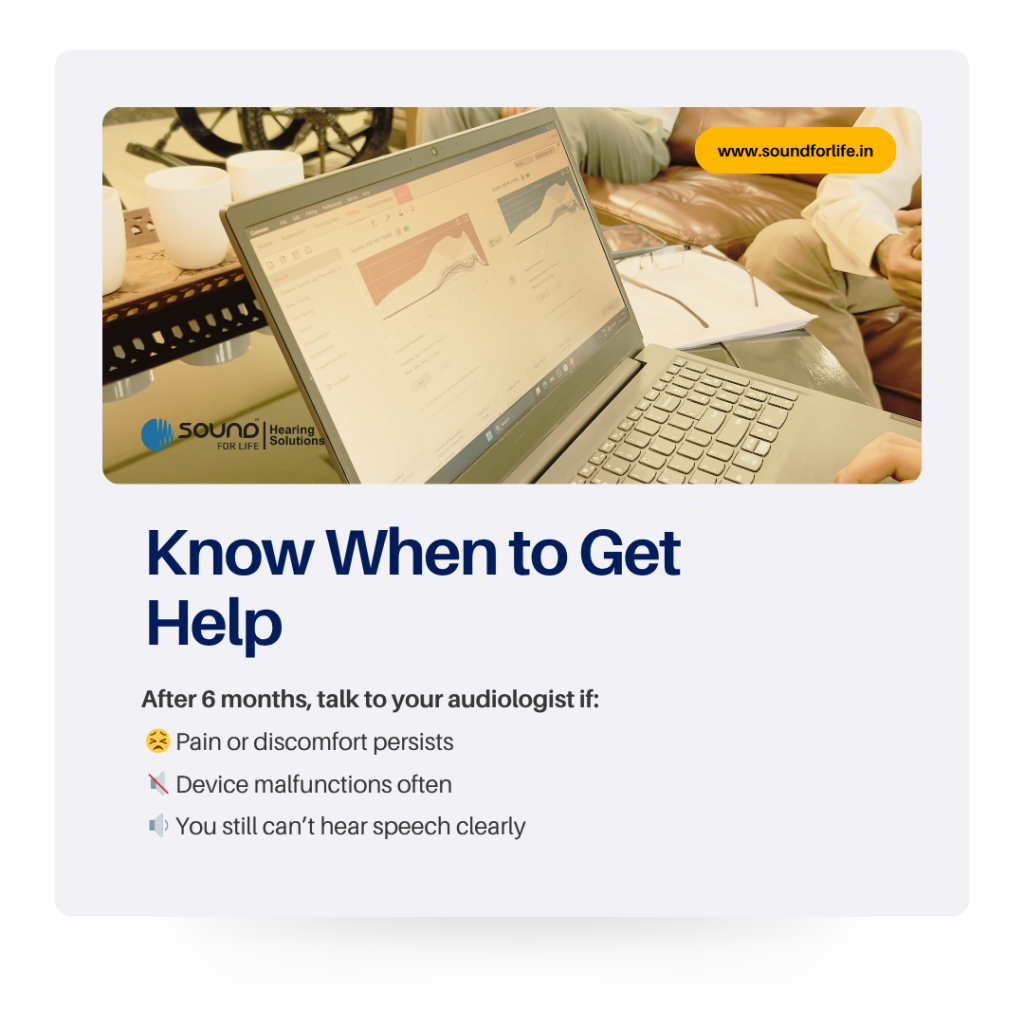
9. When to Seek Professional Help
After six months of regular use if you have or experience any of the following symptoms, get in touch with your audiologist without further delay:
- Persistent discomfort or pain
- Speech comprehension issues in most environments
- In spite of proper care and maintenance, frequently the device malfunctions.
Our specialists at SFL Hearing Solutions offer complimentary check-ups for any device fitted through us, ensuring you continue on the path to confident hearing.
Adapting to hearing aids is a slow process especially for the first time users but the result is rewarding. By around six months, you can get clear, comfortable hearing with regular usage, organised listening exercises, expert adjustments, and strong family support. Keep in mind that each user’s journey is unique, having patience and perseverance are essential.
At SFL Hearing Solutions, not only your hearing health, your general well-being remain our top priorities. For enquiries, follow-up consultations, get in touch.





